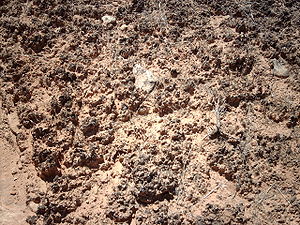
Cryptobiotic soil
Encyclopedia

Soil crust
A soil crust is a layer of soil whose particles cohere because of organic material including live organisms and what they produce.- External references :* by the USGS...
composed of living cyanobacteria, green algae
Green algae
The green algae are the large group of algae from which the embryophytes emerged. As such, they form a paraphyletic group, although the group including both green algae and embryophytes is monophyletic...
, brown algae
Brown algae
The Phaeophyceae or brown algae , is a large group of mostly marine multicellular algae, including many seaweeds of colder Northern Hemisphere waters. They play an important role in marine environments, both as food and for the habitats they form...
, fungi
Fungus
A fungus is a member of a large group of eukaryotic organisms that includes microorganisms such as yeasts and molds , as well as the more familiar mushrooms. These organisms are classified as a kingdom, Fungi, which is separate from plants, animals, and bacteria...
, lichen
Lichen
Lichens are composite organisms consisting of a symbiotic organism composed of a fungus with a photosynthetic partner , usually either a green alga or cyanobacterium...
s, and/or moss
Moss
Mosses are small, soft plants that are typically 1–10 cm tall, though some species are much larger. They commonly grow close together in clumps or mats in damp or shady locations. They do not have flowers or seeds, and their simple leaves cover the thin wiry stems...
es. Commonly found in arid regions
Desert
A desert is a landscape or region that receives an extremely low amount of precipitation, less than enough to support growth of most plants. Most deserts have an average annual precipitation of less than...
around the world, cryptobiotic soils go by many names, including cryptogamic, microbiotic, or microphytic soils or crusts. Soil crusts are important members of desert ecosystem
Ecosystem
An ecosystem is a biological environment consisting of all the organisms living in a particular area, as well as all the nonliving , physical components of the environment with which the organisms interact, such as air, soil, water and sunlight....
s and contribute to the well-being of other plants by stabilizing sand and dirt, promoting moisture retention, and fixing
Nitrogen fixation
Nitrogen fixation is the natural process, either biological or abiotic, by which nitrogen in the atmosphere is converted into ammonia . This process is essential for life because fixed nitrogen is required to biosynthesize the basic building blocks of life, e.g., nucleotides for DNA and RNA and...
atmospheric nitrogen
Nitrogen
Nitrogen is a chemical element that has the symbol N, atomic number of 7 and atomic mass 14.00674 u. Elemental nitrogen is a colorless, odorless, tasteless, and mostly inert diatomic gas at standard conditions, constituting 78.08% by volume of Earth's atmosphere...
.
Because of their thin, fiberous nature, cryptobiotic soils are extremely fragile systems. A single footprint or tire track is sufficient to disrupt the soil crust and damage the organisms. While some species within the soil crust system may regrow within a few years of a disturbance, the damage to slow-growing species may require more than a century before the delicate soil returns to its former productivity.
This sensitivity to disturbance means that travelers in arid
Arid
A region is said to be arid when it is characterized by a severe lack of available water, to the extent of hindering or even preventing the growth and development of plant and animal life...
regions should be mindful of their impact on cryptobiotic soils. As a general rule, visitors should stay on pre-existing roads and trails, only traveling off-trail on durable surfaces such as bedrock or river gravel.

